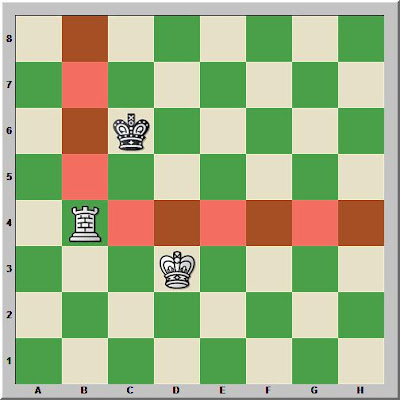For the beginning players, this week's lesson is an effort to reduce the unnecessary draws in scholastic tournaments. At Saturday's tournament, it seems that every round had at least one player chasing the opponent's king around the board with a queen: check, check, check, ... but never checkmate. Checks can be useful in the drive towards checkmate, but children have an easier time learning the correct technique if they are not allowed to check. For this training exercise, we introduce an artificial rule: no check that is not checkmate.
Players on the attacking end need to learn to control without checks.
Players on the defending side of these efforts, if they are not writing their moves, should ask for a judge to begin counting moves so that a draw by the fifty-move rule becomes a valid draw claim. Normally, a record of the moves is the necessary prerequisite for making a draw claim by the fifty-move rule, or draw by repetition. For beginning students who are playing in tournaments before learning to record the moves, a compromise is helpful. For this reason, we permit a judge to count moves upon request of a player.
Queen vs. King
Start with a king and queen of opposite colors. The player with the queen is not permitted to deliver check. The queen must drive the king to the edge of the board and towards the corner.
White to move
When the defending king is reduced to two squares, the other king appears in the far corner. Now, it is checkmate in six moves. The attacking player still delivers no checks until the checkmate. The key to quick reduction of the defending king's space is to move the queen a knight's move from the king.
White to move
Keep practicing this elementary skill until the moves feel automatic. It is important to learn to control the king by restriction, rather than assault. Reduce his choices.
Rook and King vs. King
Players who have mastered the elementary checkmate of queen and king against king are ready for one that is more challenging. A rook cannot drive a king to the edge without assistance. But, a rook and king working together can drive the king to the edge without checks.
White to move
In our starting position, White can force checkmate in sixteen moves. With our artificial rule in place, it will take more. The rules of chess allot fifty moves. A skilled player should be able to deliver checkmate in less than thirty without having checked the king prior to checkmate.
The rows of red squares mark a barrier that the king cannot cross. At the start, the Black king is trapped in a grid of thirty-six squares. White makes this grid smaller and smaller until checkmate becomes possible. The King might be checkmated anywhere along one of the edges.
To illustrate correct technique, I played against Rybka 4, an extremely strong chess engine. First, I moved my rook far from the other king along the b-file. Then, I brought my king forward. My king kept marching until my rook was in danger.
Stripes,James - Rybka 4 x64
Blitz 5m Spokane, 08.11.2011
1.Rb7 Kd3 2.Kb2 Kd4 3.Kc2 Kd5 4.Kd3 Kc6
White to move
 |
| Black threatens White's rook |
5.Rb4
The rook moves to safety. Black's grid, or corral, has been reduced to twenty-four squares.
Black to move
5...Kd6
If Black tries 5...Kc5, attacking the rook again, then 6.Rd4 reduces the grid to twelve squares.
6.Kd4 Ke6 7.Rb5
Black to move
 |
| White was concerned about the square f5 |
7...Kf6 8.Re5
Black's corral had become smaller: nine squares.
Black to move
8...Kf7 9.Kd5 Kf6 10.Kd6 Kf7
White to move
 |
| Time to move the rook |
Black to move
 |
| Black has six squares |
11...Kf8 12.Re7
Black has three squares.
12...Kg8 13.Ke6 Kf8
White to move
 |
| Which piece should move? |
14.Kf6!
14.Rf7? is a typical beginner's error. From a corral of three squares, the defending king has been given a choice of two corrals: two squares or five squares. Nearly every check offers similar choices. To win efficiently, White must reduce Black's choices.
14...Kg8 15.Kg6 Kf8
White to move
 |
| Any yellow square |
16.Re5 Kg8 17.Re8# 1–0



















No comments:
Post a Comment